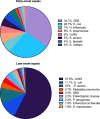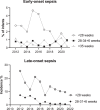Epidemiology and Outcomes of Neonatal Sepsis: Experience from a Tertiary Australian NICU
- PMID: 38889701
- PMCID: PMC11633889
- DOI: 10.1159/000539174
Epidemiology and Outcomes of Neonatal Sepsis: Experience from a Tertiary Australian NICU
Abstract
Introduction: Neonatal sepsis is associated with significant mortality and morbidity. Low-middle-income countries are disproportionately affected, but late-onset sepsis (LOS) still occurs in up to 20% of infants <28 weeks in high-income countries. Understanding site-specific data is vital to guide management.
Methods: A retrospective cohort study was conducted at King Edward Memorial Hospital (KEMH), Perth. Infants admitted between January 2012 and June 2022 were included. Data were extracted from routine electronic databases. Incidence and aetiology of sepsis were determined and the association of sepsis with neonatal outcomes analysed.
Results: During the study period, 23,395 newborns were admitted with a median gestation of 37 weeks and birth weight of 2,800 g. There were 370 sepsis episodes in 350 infants; 102 were early-onset sepsis (EOS) (1.6 per 1,000 live births), predominantly Streptococcus agalactiae (35, 34.3%) and Escherichia coli (27, 26.5%); 268 were LOS (0.9 per 1,000 inpatient days), predominantly coagulase-negative staphylococci (CONS) (156, 57.6%) and E. coli (30, 11.1%). The incidence of LOS declined from 2012 to 2022 (p = 0.002). Infants with EOS had increased brain injury (25.7% vs. 4.1%; p = 0.002) and mortality (18.8% vs. 1.6%; p < 0.001). Those with LOS had increased hospital stay (median 95 vs. 15 days; p < 0.001), mortality (15.3% vs. 1.6%; p = 0.018), necrotising enterocolitis (NEC) (7.4% vs. 0.5%; p < 0.001), and chronic lung disease (CLD) (58.1% vs. 5.9%; p = 0.005). Infants <28 weeks with sepsis were at increased risk of neurodevelopmental impairment compared to those without infection (43.2% vs. 30.9%, p = 0.027).
Conclusions: While we observed a reduction in LOS incidence, sepsis remains associated with higher mortality, and in survivors with longer hospital stay and increased risk of brain injury, NEC, CLD, and neurodevelopmental impairment.
Keywords: Early-onset sepsis; Late-onset sepsis; Neonate; Outcomes.
© 2024 The Author(s). Published by S. Karger AG, Basel.
Conflict of interest statement
The authors have no conflicts of interest to declare.
Figures
Similar articles
-
Characteristics of neonatal Sepsis at a tertiary care hospital in Saudi Arabia.J Infect Public Health. 2019 Sep-Oct;12(5):666-672. doi: 10.1016/j.jiph.2019.03.007. Epub 2019 Apr 13. J Infect Public Health. 2019. PMID: 30992228
-
Neonatal Sepsis of Early Onset, and Hospital-Acquired and Community-Acquired Late Onset: A Prospective Population-Based Cohort Study.J Pediatr. 2018 Oct;201:106-114.e4. doi: 10.1016/j.jpeds.2018.05.048. Epub 2018 Jul 24. J Pediatr. 2018. PMID: 30054165
-
Early-onset Sepsis Among Preterm Neonates in China, 2015 to 2018.Pediatr Infect Dis J. 2019 Dec;38(12):1236-1241. doi: 10.1097/INF.0000000000002492. Pediatr Infect Dis J. 2019. PMID: 31738341
-
[Neonatal sepsis: epidemiologic indicators and relation to birth weight and length of hospitalization time].An Esp Pediatr. 1998 Apr;48(4):401-8. An Esp Pediatr. 1998. PMID: 9629800 Review. Spanish.
-
Effect of gestational age on the epidemiology of late-onset sepsis in neonatal intensive care units - a review.Expert Rev Anti Infect Ther. 2017 Oct;15(10):917-924. doi: 10.1080/14787210.2017.1379394. Epub 2017 Sep 25. Expert Rev Anti Infect Ther. 2017. PMID: 28901786 Review.
Cited by
-
Epidemiology of early-onset neonatal sepsis in Qatar, 2015-2022: a multicentre retrospective cohort study.BMJ Paediatr Open. 2025 Jun 27;9(1):e003534. doi: 10.1136/bmjpo-2025-003534. BMJ Paediatr Open. 2025. PMID: 40579232 Free PMC article.
References
-
- Giannoni E, Agyeman PKA, Stocker M, Posfay-Barbe KM, Heininger U, Spycher BD, et al. . Neonatal sepsis of early onset, and hospital-acquired and community-acquired late onset: a prospective population-based cohort study. J Pediatr. 2018;201:106–14.e4. - PubMed
-
- Chow SSW, Holberton JR, Chambers GM, Lui K. Report of the Australian and New Zealand Neonatal Network 2021. ANZNN: Sydney: Australian and New Zealand Neonatal Network 2021; 2023.
MeSH terms
LinkOut - more resources
Full Text Sources




